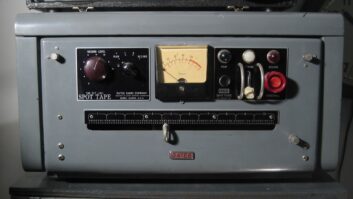
I’ve known Steve Mathews of Radio Garage Productions since radio commercials were recorded on “carts.” You remember? Those little plastic cartridges with a continuous loop of audiotape inside them?
At the time, Steve was the production director of KIMM(AM)/KGGG(FM) in Rapid City, S.D. Steve would spend his mornings typing his scripts and cart labels on his typewriter. Later in the day, he would take the scripts and wedge them between a very tall stack of carts and his chin. With a cigarette hanging out of his mouth, Steve would then rush into the production studio before the whole cart stack collapsed.
Inside the studio, Steve would spend the next couple hours smoking cigarettes and performing his own brand of radio production magic. These spots were good; no, great.
The whole radio station sounded better because of him.
Legacy
With references to “carts,” “typewriters” and “cigarettes” inside radio studios, you’ve by now realized that I have known Steve Mathews a long time. Today he is the founder/owner/head audio mechanic at Radio Garage Productions in Des Moines, Iowa, one of the top radio commercial production facilities in the country.

Steve Mathews and His Treasured Aphex Channel In addition to writing and producing radio commercials, Radio Garage does audio for online training, corporate communications, Flash, PowerPoint, etc.
For years, I have been pestering Steve to try one of my favorite professional audio products, the Aphex 230 Master Voice Channel. Over the years, I have used the 230 to make microphones and talent sound better. Finally one day, Steve caved in to my pressure and bought one for Radio Garage.
“At Radio Garage, our voice talent ranges from experienced announcers to the first-timer,” says Steve, adding, “We try to make everyone sound good no matter who they are or what mic we use. The Aphex 230 has helped us make them sound better.”
Radio Garage has been in the audio recording business for over 22 years, he said. “We produce audio for clients all over this country. From just the right compression to keep the screaming woman from clipping the audio, to adding that just right richness, to de-essing that business owner’s little girl’s voice, the Aphex really does what it says it will.”
Upgrade
Recently, Steve upgraded the Aphex 230 to the improved and rechristened Aphex Channel, so I travelled to Radio Garage in Des Moines to give Steve’s mic chain a tune-up.
The Channel has the same features as the Aphex 230, but with several improvements. On the front panel, the Channel now has separate gain reduction and peak audio meters. In the same display is a clock select-and-display feature.
Also there is a low-level input with a TRS jack on the front. Along with a new name, the panel is redesigned to reflect the product enhancements. “Sweet spot” guides for several controls are silkscreened on their respective scales.
Unchanged is the microphone preamp circuit utilizing a vacuum tube reflected plate amplifier with Aphex’s Spectral Phase Refractor circuit. Sometimes called a phase scrambler, this makes the voice signal more symmetrical and easier to process.
Why a vacuum tube in a modern audio product? “Today’s digital audio equipment is sometimes ‘too perfect’ and can often sound cold and sterile,” Steve explains. “Despite noise and other issues, the old vacuum tube gear — and even the audio tape — added something pleasing to the sound.”
I agree that certain harmonics generated by a vacuum tube amplifier are pleasing to the ear, giving warmth and detail to the audio.
Dynamic range
“We use the Channel to compress the dynamic range of the voice, giving it more clarity and impact,” Steve says. “Some people have a problem with ‘plosives,’ such as the letter ‘P.’ Pop filters can help, but we often need to back the talent off the mic. The Aphex Channel’s EasyRider compressor stage then restores voice power and presence. Problem solved.”
Product Capsule
Aphex Channel
Master Preamp & Input Processor
Thumbs Up
+ Tube preamp with Spectral Phase Refractor
+ EasyRider compressor
+ Aural Exciter
+ Big Bottom bass enhancement
+ Other goodies
Thumbs Down
– Runs a little warm
– More expensive than most mic processors
Price: MSRP $1,299; street $999
For information, contact Michael Hurwitz at Aphex in California at (818) 767-2929 or visit www.aphex.com.
Aphex’s patented Wave Dependent Compressor automatically adjusts attack-and-release times according to program complexity. A no-knee compression curve circuitry automatically adjusts compression ratio based on program levels.
Steve can also remove unwanted sibilance using the onboard de-esser threshold. Once these are set, then the remaining processor stages included in the box: the company’s “Big Bottom” bass enhancer, parametric EQ and the also famous Aural Exciter can be added to taste, or not used at all.
“We use these controls to achieve a voice effect, improve a voice or match a microphone to other audio,” he says. “The EQ is useful to increase ‘resonance’ in a voice. The Aural Exciter can enhance clarity, presence and loudness in voices; like a spice, sometimes a little bit is all that is needed.”
The final stage on the Aphex Channel is the output control; some know it as “make-up gain.” Compression and other processing can change the final output level, so check this setting anytime you make a change in processing.
The Aphex Channel provides many flavors of output signal types including balanced (+4 dBu) and unbalanced (–10 dBV) analog outputs, and AES/EBU, S/PDIF and TOSlink optical digital outputs. One more thing: Aphex recommends that to maintain the best signal to noise performance, do not feed the Aphex into a microphone level input.
DWV Entertainment Group, the parent company of Aphex is including Channel technology in its new product offerings, so as we say in our biz … Stay Tuned!
Mario Hieb, P.E., is a broadcast consulting engineer with more than 30 years of experience.







